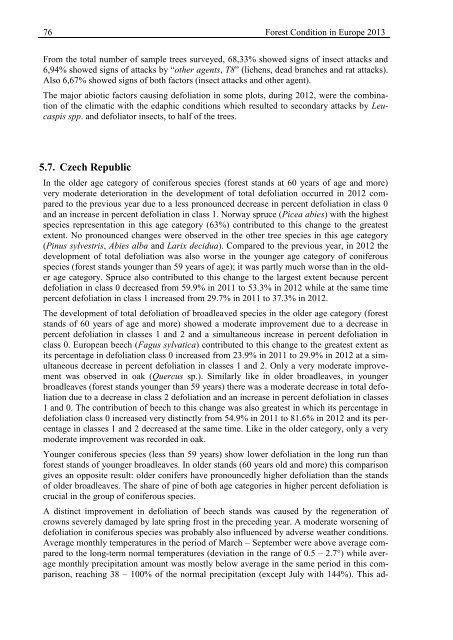Forest Condition in Europe - ICP Forests
Forest Condition in Europe - ICP Forests
Forest Condition in Europe - ICP Forests
You also want an ePaper? Increase the reach of your titles
YUMPU automatically turns print PDFs into web optimized ePapers that Google loves.
76 <strong>Forest</strong> <strong>Condition</strong> <strong>in</strong> <strong>Europe</strong> 2013<br />
From the total number of sample trees surveyed, 68,33% showed signs of <strong>in</strong>sect attacks and<br />
6,94% showed signs of attacks by “other agents, T8” (lichens, dead branches and rat attacks).<br />
Also 6,67% showed signs of both factors (<strong>in</strong>sect attacks and other agent).<br />
The major abiotic factors caus<strong>in</strong>g defoliation <strong>in</strong> some plots, dur<strong>in</strong>g 2012, were the comb<strong>in</strong>ation<br />
of the climatic with the edaphic conditions which resulted to secondary attacks by Leucaspis<br />
spp. and defoliator <strong>in</strong>sects, to half of the trees.<br />
5.7. Czech Republic<br />
In the older age category of coniferous species (forest stands at 60 years of age and more)<br />
very moderate deterioration <strong>in</strong> the development of total defoliation occurred <strong>in</strong> 2012 compared<br />
to the previous year due to a less pronounced decrease <strong>in</strong> percent defoliation <strong>in</strong> class 0<br />
and an <strong>in</strong>crease <strong>in</strong> percent defoliation <strong>in</strong> class 1. Norway spruce (Picea abies) with the highest<br />
species representation <strong>in</strong> this age category (63%) contributed to this change to the greatest<br />
extent. No pronounced changes were observed <strong>in</strong> the other tree species <strong>in</strong> this age category<br />
(P<strong>in</strong>us sylvestris, Abies alba and Larix decidua). Compared to the previous year, <strong>in</strong> 2012 the<br />
development of total defoliation was also worse <strong>in</strong> the younger age category of coniferous<br />
species (forest stands younger than 59 years of age); it was partly much worse than <strong>in</strong> the older<br />
age category. Spruce also contributed to this change to the largest extent because percent<br />
defoliation <strong>in</strong> class 0 decreased from 59.9% <strong>in</strong> 2011 to 53.3% <strong>in</strong> 2012 while at the same time<br />
percent defoliation <strong>in</strong> class 1 <strong>in</strong>creased from 29.7% <strong>in</strong> 2011 to 37.3% <strong>in</strong> 2012.<br />
The development of total defoliation of broadleaved species <strong>in</strong> the older age category (forest<br />
stands of 60 years of age and more) showed a moderate improvement due to a decrease <strong>in</strong><br />
percent defoliation <strong>in</strong> classes 1 and 2 and a simultaneous <strong>in</strong>crease <strong>in</strong> percent defoliation <strong>in</strong><br />
class 0. <strong>Europe</strong>an beech (Fagus sylvatica) contributed to this change to the greatest extent as<br />
its percentage <strong>in</strong> defoliation class 0 <strong>in</strong>creased from 23.9% <strong>in</strong> 2011 to 29.9% <strong>in</strong> 2012 at a simultaneous<br />
decrease <strong>in</strong> percent defoliation <strong>in</strong> classes 1 and 2. Only a very moderate improvement<br />
was observed <strong>in</strong> oak (Quercus sp.). Similarly like <strong>in</strong> older broadleaves, <strong>in</strong> younger<br />
broadleaves (forest stands younger than 59 years) there was a moderate decrease <strong>in</strong> total defoliation<br />
due to a decrease <strong>in</strong> class 2 defoliation and an <strong>in</strong>crease <strong>in</strong> percent defoliation <strong>in</strong> classes<br />
1 and 0. The contribution of beech to this change was also greatest <strong>in</strong> which its percentage <strong>in</strong><br />
defoliation class 0 <strong>in</strong>creased very dist<strong>in</strong>ctly from 54.9% <strong>in</strong> 2011 to 81.6% <strong>in</strong> 2012 and its percentage<br />
<strong>in</strong> classes 1 and 2 decreased at the same time. Like <strong>in</strong> the older category, only a very<br />
moderate improvement was recorded <strong>in</strong> oak.<br />
Younger coniferous species (less than 59 years) show lower defoliation <strong>in</strong> the long run than<br />
forest stands of younger broadleaves. In older stands (60 years old and more) this comparison<br />
gives an opposite result: older conifers have pronouncedly higher defoliation than the stands<br />
of older broadleaves. The share of p<strong>in</strong>e of both age categories <strong>in</strong> higher percent defoliation is<br />
crucial <strong>in</strong> the group of coniferous species.<br />
A dist<strong>in</strong>ct improvement <strong>in</strong> defoliation of beech stands was caused by the regeneration of<br />
crowns severely damaged by late spr<strong>in</strong>g frost <strong>in</strong> the preced<strong>in</strong>g year. A moderate worsen<strong>in</strong>g of<br />
defoliation <strong>in</strong> coniferous species was probably also <strong>in</strong>fluenced by adverse weather conditions.<br />
Average monthly temperatures <strong>in</strong> the period of March – September were above average compared<br />
to the long-term normal temperatures (deviation <strong>in</strong> the range of 0.5 – 2.7°) while average<br />
monthly precipitation amount was mostly below average <strong>in</strong> the same period <strong>in</strong> this comparison,<br />
reach<strong>in</strong>g 38 – 100% of the normal precipitation (except July with 144%). This ad-
















